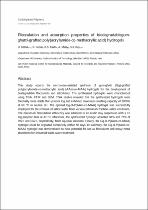 ResearchSpace
ResearchSpace
Flocculation and adsorption properties of biodegradable gum-ghatti-grafted poly(acrylamide-co-methacrylic acid) hydrogels
JavaScript is disabled for your browser. Some features of this site may not work without it.
- ResearchSpace
- →
- Research Publications/Outputs
- →
- Journal Articles
- →
- View Item
| dc.contributor.author |
Mittal, H

|
|
| dc.contributor.author |
Jindal, R

|
|
| dc.contributor.author |
Kaith, BS

|
|
| dc.contributor.author |
Maity, Arjun

|
|
| dc.contributor.author |
Ray, SS

|
|
| dc.date.accessioned | 2016-06-27T08:45:11Z | |
| dc.date.available | 2016-06-27T08:45:11Z | |
| dc.date.issued | 2015-01 | |
| dc.identifier.citation | Mittal, H. Jindal, R. Kaith, B.S. Maity, A. and Ray, S.S. 2015. Flocculation and adsorption properties of biodegradable gum-ghatti-grafted poly(acrylamide-co-methacrylic acid) hydrogels. Carbohydrate Polymers, 115, 617-628 | en_US |
| dc.identifier.issn | 0144-8617 | |
| dc.identifier.uri | http://www.sciencedirect.com/science/article/pii/S0144861714009230 | |
| dc.identifier.uri | http://hdl.handle.net/10204/8598 | |
| dc.description | Copyright: 2015 Elsevier. Due to copyright restrictions, the attached PDF file only contains the abstract of the full text item. For access to the full text item, please consult the publisher's website. The definitive version of the work is published in the Carbohydrate Polymers, 115, 617-628 | en_US |
| dc.description.abstract | This study reports the microwave-assisted synthesis of gum-ghatti (Gg)-grafted poly(acrylamide-co-methacrylic acid) (AAm-co-MAA) hydrogels for the development of biodegradable flocculants and adsorbents. The synthesized hydrogels were characterized using TGA, FTIR and SEM. TGA studies revealed that the synthesized hydrogels were thermally more stable than pristine Gg and exhibited maximum swelling capacity of 1959% at 60 °C in neutral pH. The optimal Gg-cl-P(AAm-co-MAA) hydrogel was successfully employed for the removal of saline water from various petroleum fraction–saline emulsions. The maximum flocculation efficiency was achieved in an acidic clay suspension with a 15 mg polymer dose at 40 °C. Moreover, the synthesized hydrogel adsorbed 94% and 75% of Pb2+ and Cu2+, respectively, from aqueous solutions. Finally, the Gg-cl-P(AAm-co-MAA) hydrogel could be degraded completely within 50 days. In summary, the Gg-cl-P(AAm-co-MAA) hydrogel was demonstrated to have potential for use as flocculants and heavy metal absorbents for industrial waste water treatment. | en_US |
| dc.language.iso | en | en_US |
| dc.publisher | Elsevier | en_US |
| dc.relation.ispartofseries | Workflow;16381 | |
| dc.subject | Gum ghatti | en_US |
| dc.subject | Hydrogel polymer | en_US |
| dc.subject | Graft co-polymerization | en_US |
| dc.subject | Biodegradation | en_US |
| dc.subject | Flocculation | en_US |
| dc.subject | Adsorption | en_US |
| dc.title | Flocculation and adsorption properties of biodegradable gum-ghatti-grafted poly(acrylamide-co-methacrylic acid) hydrogels | en_US |
| dc.type | Article | en_US |
| dc.identifier.apacitation | Mittal, H., Jindal, R., Kaith, B., Maity, A., & Ray, S. (2015). Flocculation and adsorption properties of biodegradable gum-ghatti-grafted poly(acrylamide-co-methacrylic acid) hydrogels. http://hdl.handle.net/10204/8598 | en_ZA |
| dc.identifier.chicagocitation | Mittal, H, R Jindal, BS Kaith, Arjun Maity, and SS Ray "Flocculation and adsorption properties of biodegradable gum-ghatti-grafted poly(acrylamide-co-methacrylic acid) hydrogels." (2015) http://hdl.handle.net/10204/8598 | en_ZA |
| dc.identifier.vancouvercitation | Mittal H, Jindal R, Kaith B, Maity A, Ray S. Flocculation and adsorption properties of biodegradable gum-ghatti-grafted poly(acrylamide-co-methacrylic acid) hydrogels. 2015; http://hdl.handle.net/10204/8598. | en_ZA |
| dc.identifier.ris | TY - Article AU - Mittal, H AU - Jindal, R AU - Kaith, BS AU - Maity, Arjun AU - Ray, SS AB - This study reports the microwave-assisted synthesis of gum-ghatti (Gg)-grafted poly(acrylamide-co-methacrylic acid) (AAm-co-MAA) hydrogels for the development of biodegradable flocculants and adsorbents. The synthesized hydrogels were characterized using TGA, FTIR and SEM. TGA studies revealed that the synthesized hydrogels were thermally more stable than pristine Gg and exhibited maximum swelling capacity of 1959% at 60 °C in neutral pH. The optimal Gg-cl-P(AAm-co-MAA) hydrogel was successfully employed for the removal of saline water from various petroleum fraction–saline emulsions. The maximum flocculation efficiency was achieved in an acidic clay suspension with a 15 mg polymer dose at 40 °C. Moreover, the synthesized hydrogel adsorbed 94% and 75% of Pb2+ and Cu2+, respectively, from aqueous solutions. Finally, the Gg-cl-P(AAm-co-MAA) hydrogel could be degraded completely within 50 days. In summary, the Gg-cl-P(AAm-co-MAA) hydrogel was demonstrated to have potential for use as flocculants and heavy metal absorbents for industrial waste water treatment. DA - 2015-01 DB - ResearchSpace DP - CSIR KW - Gum ghatti KW - Hydrogel polymer KW - Graft co-polymerization KW - Biodegradation KW - Flocculation KW - Adsorption LK - https://researchspace.csir.co.za PY - 2015 SM - 0144-8617 T1 - Flocculation and adsorption properties of biodegradable gum-ghatti-grafted poly(acrylamide-co-methacrylic acid) hydrogels TI - Flocculation and adsorption properties of biodegradable gum-ghatti-grafted poly(acrylamide-co-methacrylic acid) hydrogels UR - http://hdl.handle.net/10204/8598 ER - | en_ZA |





